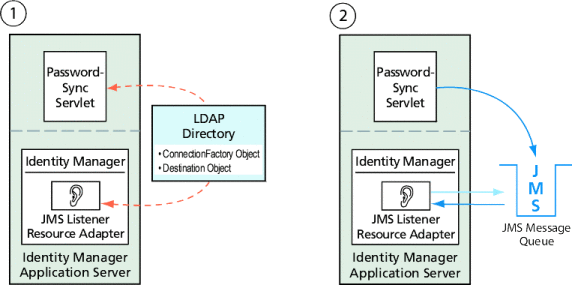Storing Administered Objects in an LDAP Directory
PasswordSync and the JMS Listener can be configured to use administered objects stored in an LDAP directory. Figure 11–14 illustrates the process. Both the PasswordSync Servlet and the JMS Listener adapter must retrieve connection factory and destination settings from the LDAP Directory in order to send and receive messages.
Figure 11–14 Retrieving Connection Factory and Destination Objects from the LDAP Directory

Using the Message Queue Command-Line Tool
This section explains how to use the Message Queue command-line tool (imqobjmgr) to store administered objects in an LDAP directory.
Storing Connection Factory Objects
Open the Message Queue command-line tool (imqobjmgr) and type the commands in Storing Connection Factory Objects to store the connection factory objects.
Example 11–1 Storing Connection Factory Objects
#> ./imqobjmgr add -l "cn=mytestFactory" -j "java.naming.factory.initial=com.sun.jndi.ldap.LdapCtxFactory" -j "java.naming.provider.url=ldap://gwenig.coopsrc.com:389/ou=sunmq,dc=coopsrc,dc=com" -j "java.naming.security.principal=cn=directory manager" -j "java.naming.security.credentials=password" -j "java.naming.security.authentication=simple" -t qf -o "imqAddressList=mq://gwenig.coopsrc.com:7676/jms" Adding a Queue Connection Factory object with the following attributes: imqAckOnAcknowledge [Message Service Acknowledgement of Client Acknowledgements] ... imqSetJMSXUserID [Enable JMSXUserID Message Property] false Using the following lookup name: cn=mytestFactory The object’s read-only state: false To the object store specified by: java.naming.factory.initial com.sun.jndi.ldap.LdapCtxFactory java.naming.provider.url ldap://gwenig.coopsrc.com:389/ou=sunmq,dc=coopsrc,dc=com java.naming.security.authentication simple java.naming.security.credentials netscape java.naming.security.principal cn=directory manager Object successfully added. |
In Storing Connection Factory Objects imqAddressList defines the JMS server/broker hostname (gwenig.coopsrc.com), port (7676), and the access method (jms).
Storing Destination Objects
In the Message Queue command-line tool (imqobjmgr), type the commands in Storing Destination Objects to store the destination objects.
Example 11–2 Storing Destination Objects
#> ./imqobjmgr add -l "cn=mytestDestination" -j "java.naming.factory.initial=com.sun.jndi.ldap.LdapCtxFactory" -j "java.naming.provider.url=ldap://gwenig.coopsrc.com:389/ou=sunmq,dc=coopsrc,dc=com" -j "java.naming.security.principal=cn=directory manager" -j "java.naming.security.credentials=password" -j "java.naming.security.authentication=simple" -t q -o "imqDestinationName=mytestDestination" Adding a Queue object with the following attributes: imqDestinationDescription [Destination Description] A Description for the Destination Object imqDestinationName [Destination Name] mytestDestination Using the following lookup name: cn=mytestDestination The object’s read-only state: false To the object store specified by: java.naming.factory.initial com.sun.jndi.ldap.LdapCtxFactory java.naming.provider.url ldap://gwenig.coopsrc.com:389/ ou=sunmq,dc=coopsrc,dc=com java.naming.security.authentication simple java.naming.security.credentials netscape java.naming.security.principal cn=directory manager Object successfully added. |
You can check the newly created object with an ldapsearch or an LDAP browser.
This concludes the section on Storing Administered Objects on an LDAP Server. Skip the next section, which describes how to store Administered Objects in a file, and go to the section on Configuring the JMS Listener Adapter for this Scenario.
- © 2010, Oracle Corporation and/or its affiliates
